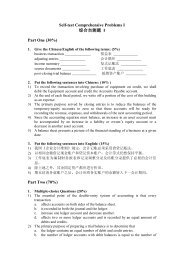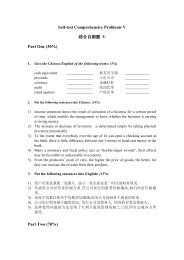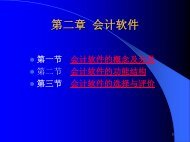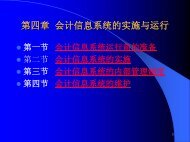Vodafone Group Plc Annual Report for the year ended 31 March 2012
Vodafone Group Plc Annual Report for the year ended 31 March 2012
Vodafone Group Plc Annual Report for the year ended 31 March 2012
You also want an ePaper? Increase the reach of your titles
YUMPU automatically turns print PDFs into web optimized ePapers that Google loves.
<strong>Vodafone</strong> <strong>Group</strong> <strong>Plc</strong><br />
<strong>Annual</strong> <strong>Report</strong> <strong>2012</strong><br />
99<br />
The <strong>Group</strong> has also not adopted <strong>the</strong> following pronouncements which are effective <strong>for</strong> annual periods beginning on or after 1 January 2013<br />
and have not yet been endorsed <strong>for</strong> use in <strong>the</strong> EU. The <strong>Group</strong> has not completed its assessment of <strong>the</strong> impact of <strong>the</strong>se pronouncements on <strong>the</strong><br />
consolidated results, financial position or cash flows of <strong>the</strong> <strong>Group</strong>. However, <strong>the</strong> <strong>Group</strong> currently expects that IFRS 11, “Joint Arrangements”, will have<br />
a material impact on <strong>the</strong> presentation of <strong>the</strong> <strong>Group</strong>’s interests in its joint ventures owing to <strong>the</strong> <strong>Group</strong>’s significant investments in joint ventures as<br />
discussed in note 13.<br />
aa<br />
IFRS 10, “Consolidated Financial Statements”, which replaces parts of IAS 27, “Consolidated and Separate Financial Statements” and all of SIC-12,<br />
“Consolidation – Special Purpose Entities”, builds on existing principles by identifying <strong>the</strong> concept of control as <strong>the</strong> determining factor in whe<strong>the</strong>r<br />
an entity should be included within <strong>the</strong> consolidated financial statements of <strong>the</strong> parent company. The remainder of IAS 27, “Separate Financial<br />
Statements”, now contains accounting and disclosure requirements <strong>for</strong> investments in subsidiaries, joint ventures and associates only when an<br />
entity prepares separate financial statements and is <strong>the</strong>re<strong>for</strong>e not applicable in <strong>the</strong> <strong>Group</strong>’s consolidated financial statements.<br />
aa<br />
IFRS 11, “Joint Arrangements”, which replaces IAS <strong>31</strong>, “Interests in Joint Ventures” and SIC-13, “Jointly Controlled Entities – Non-monetary<br />
Contributions by Venturers”, requires a single method, known as <strong>the</strong> equity method, to account <strong>for</strong> interests in jointly controlled entities which<br />
is consistent with <strong>the</strong> accounting treatment currently applied to investments in associates. The proportionate consolidation method currently<br />
applied to <strong>the</strong> <strong>Group</strong>’s interests in joint ventures is prohibited. IAS 28, “Investments in Associates and Joint Ventures”, was am<strong>ended</strong> as a<br />
consequence of <strong>the</strong> issuance of IFRS 11. In addition to prescribing <strong>the</strong> accounting <strong>for</strong> investment in associates, it now sets out <strong>the</strong> requirements<br />
<strong>for</strong> <strong>the</strong> application of <strong>the</strong> equity method when accounting <strong>for</strong> joint ventures. The application of <strong>the</strong> equity method has not changed as a result of<br />
this amendment.<br />
aa<br />
IFRS 12, “Disclosure of Interest in O<strong>the</strong>r Entities”, is a new and comprehensive standard on disclosure requirements <strong>for</strong> all <strong>for</strong>ms of interests in<br />
o<strong>the</strong>r entities, including joint arrangements, associates, special purpose vehicles and o<strong>the</strong>r off balance sheet vehicles. The standard includes<br />
disclosure requirements <strong>for</strong> entities covered under IFRS 10 and IFRS 11.<br />
aa<br />
IFRS 13, “Fair Value Measurement”, provides guidance on how fair value should be applied where its use is already required or permitted by o<strong>the</strong>r<br />
standards within IFRS, including a precise definition of fair value and a single source of fair value measurement and disclosure requirements <strong>for</strong><br />
use across IFRS.<br />
aa<br />
Amendments to IAS 19, “Employee benefits”, require a revised allocation of costs <strong>for</strong> defined benefit pension schemes between <strong>the</strong> income<br />
statement and o<strong>the</strong>r comprehensive income and prohibit <strong>the</strong> use of <strong>the</strong> “corridor approach” to spread <strong>the</strong> recognition of actuarial gains and<br />
losses, which is not used by <strong>the</strong> <strong>Group</strong>, and require a different measurement basis <strong>for</strong> asset returns. The amendments also include a revised<br />
definition of short- and long-term benefits to employees and revised criteria <strong>for</strong> <strong>the</strong> recognition of termination benefits.<br />
Basis of consolidation<br />
The consolidated financial statements incorporate <strong>the</strong> financial statements of <strong>the</strong> Company and entities controlled, both unilaterally and jointly, by<br />
<strong>the</strong> Company.<br />
Accounting <strong>for</strong> subsidiaries<br />
A subsidiary is an entity controlled by <strong>the</strong> Company. Control is achieved where <strong>the</strong> Company has <strong>the</strong> power to govern <strong>the</strong> financial and operating<br />
policies of an entity so as to obtain benefits from its activities.<br />
The results of subsidiaries acquired or disposed of during <strong>the</strong> <strong>year</strong> are included in <strong>the</strong> income statement from <strong>the</strong> effective date of acquisition or up<br />
to <strong>the</strong> effective date of disposal, as appropriate. Where necessary, adjustments are made to <strong>the</strong> financial statements of subsidiaries to bring <strong>the</strong>ir<br />
accounting policies into line with those used by <strong>the</strong> <strong>Group</strong>.<br />
All intra-group transactions, balances, income and expenses are eliminated on consolidation.<br />
Non-controlling interests in <strong>the</strong> net assets of consolidated subsidiaries are identified separately from <strong>the</strong> <strong>Group</strong>’s equity <strong>the</strong>rein. Non-controlling<br />
interests consist of <strong>the</strong> amount of those interests at <strong>the</strong> date of <strong>the</strong> original business combination and <strong>the</strong> non-controlling shareholder’s share of<br />
changes in equity since <strong>the</strong> date of <strong>the</strong> combination. Total comprehensive income is attributed to non-controlling interests even if this results in <strong>the</strong><br />
non-controlling interests having a deficit balance.<br />
Business combinations<br />
Acquisitions of subsidiaries are accounted <strong>for</strong> using <strong>the</strong> acquisition method. The cost of <strong>the</strong> acquisition is measured at <strong>the</strong> aggregate of <strong>the</strong> fair<br />
values, at <strong>the</strong> date of exchange, of assets given, liabilities incurred or assumed, and equity instruments issued by <strong>the</strong> <strong>Group</strong>. Acquisition-related<br />
costs are recognised in <strong>the</strong> income statement as incurred. The acquiree’s identifiable assets and liabilities are recognised at <strong>the</strong>ir fair values at <strong>the</strong><br />
acquisition date.<br />
Goodwill is measured as <strong>the</strong> excess of <strong>the</strong> sum of <strong>the</strong> consideration transferred, <strong>the</strong> amount of any non-controlling interests in <strong>the</strong> acquiree and<br />
<strong>the</strong> fair value of <strong>the</strong> <strong>Group</strong>’s previously held equity interest in <strong>the</strong> acquiree, if any, over <strong>the</strong> net amounts of identifiable assets acquired and liabilities<br />
assumed at <strong>the</strong> acquisition date.<br />
The interest of <strong>the</strong> non-controlling shareholders in <strong>the</strong> acquiree may initially be measured ei<strong>the</strong>r at fair value or at <strong>the</strong> non-controlling shareholders’<br />
proportion of <strong>the</strong> net fair value of <strong>the</strong> identifiable assets acquired, liabilities and contingent liabilities assumed. The choice of measurement basis is<br />
made on an acquisition-by-acquisition basis.<br />
Acquisition of interests from non-controlling shareholders<br />
In transactions with non-controlling parties that do not result in a change in control, <strong>the</strong> difference between <strong>the</strong> fair value of <strong>the</strong> consideration paid<br />
or received and <strong>the</strong> amount by which <strong>the</strong> non-controlling interest is adjusted is recognised in equity.<br />
Business review Per<strong>for</strong>mance Governance Financials Additional in<strong>for</strong>mation






